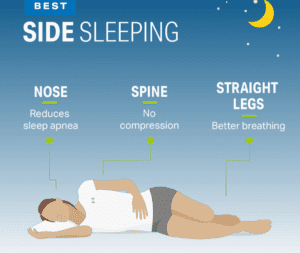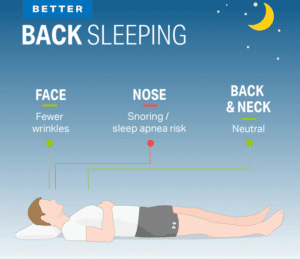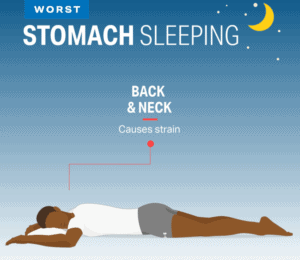All too often I’ll meet with a client early in the morning, and they proceed to tell me how stiff they are in the back, neck and shoulders. After a few questions, we typically come to the conclusion that sleeping position may have caused or exacerbated the discomfort. Sleeping position is critical for proper body alignment. We all agree that sleep plays an integral part in our overall health, but no one ever teaches us the proper position for doing it. So the question is how can we get better sleep and what positions are best for our body from an anatomical point of view.
Here is what you need to know:
Side sleepers

Sleeping on your side is the most common and probably best sleeping position. It tends to be comfortable for most people and positions the spine in a way that takes compression off the discs. However, there are a few things to keep in mind when choosing a side. First, sleeping on your left side has shown to alleviate acid reflux and heartburn, aid in digestion, and improves circulation. Secondly, side sleeping may put excess pressure on your shoulders and create arm numbness from resting on a single arm for too long. Over the long run, this can lead to more shoulder dysfunction. Lastly, make sure to keep a pillow between your knees and avoid drawing both knees towards your chest. The pillow will keep your hips in better alignment and stretching your legs out will prevent your hip flexors from becoming over tight. A common cause of low back tightness.
Back Sleepers
 Back sleeping is a good position because it keeps your spine and neck in a neutral position. You can make it even better by adding a pillow under the back of your knees for optimal spinal alignment. This may also be a good position for those worried about aesthetics. Sleeping in this position helps to minimize unnecessary wrinkles on your face. However, for those of us who suffer from snoring or sleep apnea, lying on your back can cause the tongue to collapse and obstruct the airway making it difficult to breath.
Back sleeping is a good position because it keeps your spine and neck in a neutral position. You can make it even better by adding a pillow under the back of your knees for optimal spinal alignment. This may also be a good position for those worried about aesthetics. Sleeping in this position helps to minimize unnecessary wrinkles on your face. However, for those of us who suffer from snoring or sleep apnea, lying on your back can cause the tongue to collapse and obstruct the airway making it difficult to breath.
Stomach Sleepers
 Sleeping on your stomach is probably the WORST of all positions! It puts strain on your low back by flattening out the natural curve of your spine and can increase sacroiliac joint discomfort. Plus, it causes excess tension on your neck due to having your head turned to one side or the other. Hands over your head leads to even more dysfunction, this time in your shoulders and traps. If you absolutely must sleep in this position, try propping a pillow under your lower abdomen and hips to give your spine a lift and keep your hands down by your sides.
Sleeping on your stomach is probably the WORST of all positions! It puts strain on your low back by flattening out the natural curve of your spine and can increase sacroiliac joint discomfort. Plus, it causes excess tension on your neck due to having your head turned to one side or the other. Hands over your head leads to even more dysfunction, this time in your shoulders and traps. If you absolutely must sleep in this position, try propping a pillow under your lower abdomen and hips to give your spine a lift and keep your hands down by your sides.
The most important takeaway is the critical role that sleep plays on our overall health. It’s the time your body heals and repairs itself. Studies show getting a minimum of 6-8 hours a night helps to reduce the risk of heart disease, kidney disease, high blood pressure, diabetes, and stroke. Sleeping is a very personal experience for everyone, so find a position that is most comfortable while keeping in my the information we discussed.
